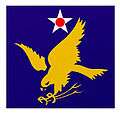512th Rescue Squadron
The 512th Rescue Squadron is part of the 58th Special Operations Wing based at Kirtland Air Force Base, New Mexico. It operates Bell UH-1N Twin Huey and Sikorsky HH-60G Pave Hawk helicopters training aircrew conducting search and rescue missions.
512th Rescue Squadron
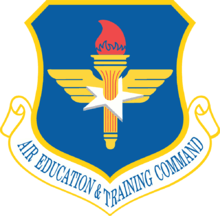 | |
|---|---|
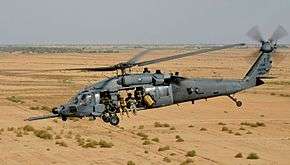 HH-60 Pave Hawk as flown by the squadron | |
| Active | 1942–1946; 1947–1948; 1949–1951; 1951–1965; 1994–present |
| Country | |
| Branch | |
| Role | Search and Rescue Training |
| Part of | Air Education and Training Command |
| Garrison/HQ | Kirtland Air Force Base |
| Engagements | Mediterranean Theater of Operations Korean war |
| Decorations | Distinguished Unit Citation Air Force Outstanding Unit Award |
| Insignia | |
| 512th Rescue Squadron emblem (approved 13 April 1995)[1] | 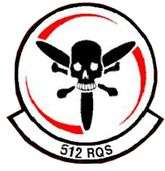 |
| 512th Bombardment Squadron emblem (approved 6 January 1944)[1] | 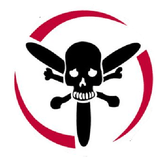 |
The squadron was formed as the 512th Bombardment Squadron in the Middle East in 1942 to reinforce the Royal Air Force in North Africa with personnel and aircraft diverted from delivery to the China Burma India Theater. The squadron moved forward, eventually being stationed in Italy, where it participated in the strategic bombing campaign against Germany, and was awarded three Distinguished Unit Citations for its combat actions. Following V-E Day, the squadron returned to the United States, where it converted to Boeing B-29 Superfortress bombers, but was inactivated in March 1946.
The squadron was redesignated the 512th Reconnaissance Squadron and activated in 1947 as a weather reconnaissance unit. Except for a brief period of inactivation in the winter of 1948–1949, it continued the reconnaissance mission until February 1951, when it was inactivated and its assets transferred to another squadron.
The squadron returned to the bombardment mission later that year, and upgraded to jet Boeing B-47 Stratojet bombers in 1954. It continued to fly the Stratojet until they were phased out of the Air Force inventory, and the squadron was inactivated in 1965.
The squadron was activated as the 512th Special Operations Squadron in April 1994 and assumed its mission of training helicopter aircrews.
Mission
The squadron mission is to provide trained Bell UH-1N Twin Huey and Sikorsky HH-60G Pave Hawk crewmembers to Helicopter Units Worldwide[2]
History
World War II
Background
In early 1942, the Afrika Corps was threatening British forces in Egypt. In response, two contingents of American heavy bombers were diverted to support them. A flight of Consolidated B-24 Liberators being ferried to India was halted from their travel in June and some Boeing B-17 Flying Fortresses from the 9th and 436th Bombardment Squadrons were flown to the Middle East from India. On 20 July 1942, these elements were organized into the 1st Provisional Group at RAF Lydda, Palestine.[3]
North African operations

On 31 October 1942, the 1st Group was dissolved and replaced by a formal Army Air Forces unit, the 376th Bombardment Group.[4] The 512th Bombardment Squadron was activated as one of its four component squadrons.[1][5] The squadron was originally equipped with a mix of Liberators and Flying Fortresses, but by the end of the year, the B-17s were transferred to Twelfth Air Force and the squadron became an all B-24 unit.[6]
Moving forward to bases in Egypt and Libya, the squadron attacked shipping in the Mediterranean and harbor installations in Libya, Tunisia, Sicily, and Italy to cut enemy supply lines to North Africa. After the fall of Tunisia in May 1943, the squadron focused on attacks on airdromes, marshalling yards, and other objectives in Sicily and Italy, moving forward to Enfidaville Airfield, Tunisia in late September. Its actions during these attacks on enemy targets from its activation through August 1943 earned the squadron its first Distinguished Unit Citation (DUC).[5]
On 1 August 1943, operating from Benina Airport, Libya, the squadron participated in Operation Tidal Wave, the low level attack on oil refineries near Ploesti, with the squadron's parent group leading the attack formation.[7] As it approached its assigned targets, the lead aircraft realized that an order from the group commander, who had misidentified the initial point, put the group off course.[8] The group attempted an attack on the Romana Americana[9] refinery, its assigned objective from a different direction. By this time, enemy air defenses had been alerted and intense flak forced the unit to attack targets of opportunity. The squadron was awarded its second DUC for this operation.[5]
Strategic bombing campaign
The squadron moved to San Pancrazio Airfield, Italy in November 1943, where it became part of Fifteenth Air Force and would remain until April 1945. It primarily flew long range strategic bombardment missions to targets in Italy, France, Germany, Czechoslovakia, Austria, Hungary, and the Balkans to bomb factories, marshalling yards, oil refineries, oil storage facilities, airdromes, bridges, harbors, and other objectives. On 16 June 1944, it received a third DUC for an attack on oil industry targets in Bratislava. The squadron also provided air support for Operation Shingle, the landings at Anzio and flew interdiction missions to support the Battle of Monte Cassino between February and March 1944. In the fall of 1944, it assisted the Red Army in its advance through the Balkans, and in early 1945, supported Operation Grapeshot, the spring offensive in Northern Italy. The squadron was withdrawn from combat in April 1945 and left Italy for the United States.[1][5]
The squadron arrived at Harvard Army Air Field, Nebraska in May 1945 and began conversion to the Boeing B-29 Superfortress. However the war in the Paciic ended before the squadron was fully trained. After it moved to Fort Worth Army Air Field, Texas on 10 November, the squadron was not fully manned or equipped. It was inactivated on 28 March 1946,[1] and most of its resources at Roswell Army Air Field, New Mexico were absorbed by the 509th Bombardment Group.
Weather reconnaissance
The squadron was redesignated the 512th Reconnaissance Squadron and activated at Gravelly Point, Virginia in May 1947. Although the squadron was reassigned to Air Weather Service in September, and to the 308th Reconnaissance Group in October, it was not manned before inactivating on 20 September 1948.[1]
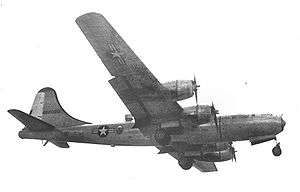
The squadron was reactivated at Fairfield-Suisun Air Force Base, California in February 1949. After drawing its cadre and training with the 2078th Weather Reconnaissance Squadron on various models of the Boeing B-29 Superfortress, the squadron moved to Yokota Air Base, Japan in January 1950.[1] Air Weather Service reorganized its weather reconnaissance assets at this time, inactivating the 308th Reconnaissance Group,[10] and reassigning its squadrons to its regional headquarters. This resulted in the assignment of the squadron to the 2143d Air Weather Wing.[1]
The squadron was located at Yokota when the Korean War began in June.[1] It began to perform daily weather reconnaissance missions over the combat zone. It conducted shipping surveillance and visual reconnaissance, and also performed electronic countermeasures reconnaissance. In the early days of the conflict, the squadron also dropped leaflets. Initially unarmed, and later only lightly armed with two .50-caliber machine guns in the tail turret, unit WB-29s flew daily missions over enemy-held territory.[11]
From 27 June through 27 December 1950, the squadron flew over 200 combat missions, making over 5,000 weather observations. These missions were "exceptionally hazardous" because of varying weather conditions and exposure to attack over enemy territory. One of the squadron's WB-29s served as an aerial command post and weather station, giving on-the-spot weather data and directions to incoming bombers on the first B-29 strike against North Korean installations. On this and several later such missions, the WB-29 carried Major General Emmett O'Donnell, Jr., Commander of Far East Air Forces Bomber Command. These actions earned the squadron one of the first Air Force Outstanding Unit Awards awarded.[11] The squadron was inactivated and replaced by the 56th Strategic Reconnaissance Squadron in February 1951.[1][11]
Strategic Air Command
_(2).jpg)
The squadron was redesignated the 512th Bombardment Squadron and reactivated at Forbes Air Force Base, Kansas in June 1951. The squadron was again equipped with Superfortress bombers and assigned to the 376th Group. It began training in strategic bombardment in August. However, SAC’s mobilization for the Korean War highlighted that SAC wing commanders focused too much on running the base organization and did not spend enough time on overseeing actual combat preparations. To allow wing commanders the ability to focus on combat operations, the air base group commander became responsible for managing the base housekeeping functions. Under the plan implemented in February 1951 and finalized in June 1952, the wing commander focused primarily on the combat units and the maintenance necessary to support combat aircraft by having the combat and maintenance squadrons report directly to the wing and eliminating the intermediate group structures.[12] As a result of this "dual deputy" reorganization, the 376th Group was inactivated and the squadron was assigned directly to the 376th Bombardment Wing in June 1952.[1]
The squadron moved to Barksdale Air Force Base, Louisiana in October. By November 1952, electronic countermeasures (ECM) training began to predominate over bombardment, and by September 1953, ECM had become the unit's primary mission.[1][13] In 1954, the squadron converted to Boeing B-47 Stratojet jet medium bombers. From July to October 1955, the squadron deployed to RAF Upper Heyford, England as part of Operation Reflex, maintaining bombers on alert at the advanced station.[1] Reflex placed Stratojets and Boeing KC-97s at bases closer to the Soviet Union for 90-day periods, although individuals rotated back to home bases during unit Reflex deployments[14] However, after 1958, Strategic Air Command (SAC) B-47 units began to assume an alert posture at their home bases, reducing the amount of time spent on alert at overseas bases[15] and the squadron did not deploy again as a unit. It moved again in 1957, this time to Lockbourne Air Force Base, Ohio.
During the 1962 Cuban Missile Crisis, SAC dispersed its B-47s on 22 October. Most dispersal bases were civilian airfields with Reserve or Air National Guard units. B-47s were configured for execution of the Emergency War Order as soon as possible after dispersal.[16] On 24 October SAC went to DEFCON 2, placing all aircraft on alert.[17] On 15 November 1/6 of the dispersed B-47s were recalled to their home bases. The remaining dispersed B-47s and supporting tankers were recalled on 24 November. On 27 November SAC returned to normal alert posture.[18] The squadron continued to train in electronic warfare techniques until beginning to phase down for inactivation in March 1965 with the retirement of the Stratojet from SAC's inventory.[1][13]
Helicopter training
The squadron was activated at Kirtland Air Force Base, New Mexico as the 512th Special Operations Squadron in April 1994, when the 58th Special Operations Wing replaced the 542d Crew Training Wing at Kirtland.[1][19][20] The squadron retained its mission of training helicopter aircrew and participation in special operations contingencies, exercises, and humanitarian rescue helicopter training despite a change to its current name in October 2000.[2]
Lineage
- Constituted as the 512th Bombardment Squadron (Heavy) on 19 October 1942
- Activated on 31 October 1942
- Redesignated 512th Bombardment Squadron, Heavy on 3 May 1944
- Redesignated 512th Bombardment Squadron, Very Heavy on 23 May 1945
- Inactivated on 26 March 1946
- Redesignated 512th Reconnaissance Squadron, Very Long-Range, Weather on 6 May 1947
- Activated on 23 May 1947
- Inactivated on 20 September 1948
- Activated on 13 February 1949
- Inactivated on 20 February 1951
- Redesignated 512th Bombardment Squadron, Medium on 25 May 1951
- Activated on 1 June 1951
- Inactivated on 15 March 1965
- Redesignated 512th Special Operations Squadron on 25 March 1994
- Activated on 1 April 1994
- Redesignated 512th Rescue Squadron on 6 October 2000[1]
Assignments
- 376th Bombardment Group, 31 October 1942
- 468th Bombardment Group, 10 November 1945 – 26 March 1946
- 376th Reconnaissance Group, 23 May 1947
- Air Weather Service, 16 September 1947
- 308th Reconnaissance Group, 14 October 1947 – 20 September 1948
- 308th Reconnaissance Group, 1 February 1949
- 2143d Air Weather Wing, 14 November 1949 – 20 February 1951
- 376th Bombardment Group, 1 June 1951
- 376th Bombardment Wing, 16 June 1952 – 15 March 1965
- 58th Operations Group, 1 April 1994 – present[1]
Stations
|
|
Aircraft
- Boeing B-17 Flying Fortress (1942)
- Convair B-24 Liberator (1942–1945)
- Boeing B-29 Superfortress (1945, 1949–1951, 1951–1954)
- Boeing RB-29 Superfortress (1949–1951)
- Boeing WB-29 Superfortress (1949–1951)
- Douglas C-47 Skytrain (1949–1950)
- Douglas C-54 Skymaster (1950–1951)
- Boeing B-47 Stratojet (1954–1961)
- Boeing E-47 (later EB-470 Stratojet (1961–1965)
- Bell UH-1N Twin Huey (1994–present)
- Sikorsky HH-60 Pave Hawk (1994–present)[1]
Awards and campaigns
| Award streamer | Award | Dates | Notes |
|---|---|---|---|
| Distinguished Unit Citation | November 1942-17 August 1943 | North Africa and Sicily, 512th Bombardment Squadron[1] | |
| Distinguished Unit Citation | 1 August 1943 | Ploesti, Romania, 512th Bombardment Squadron[1] | |
| Distinguished Unit Citation | 16 June 1944 | Bratislava, Czechoslovakia, 512th Bombardment Squadron[1] | |
| Air Force Outstanding Unit Award | 27 June 1950-27 December 1950 | 512th Reconnaissance Squadron[1] | |
| Air Force Outstanding Unit Award | 1 July 1994-30 June 1995 | 512th Special Operations Squadron[21] | |
| Air Force Outstanding Unit Award | 1 July 1998-30 June 2000 | 512th Special Operations Squadron[1] | |
| Air Force Outstanding Unit Award | 1 July 2001 – 30 June 2002 | 512th Rescue Squadron[1] | |
| Air Force Outstanding Unit Award | 1 July 2002 – 30 June 2003 | 512th Rescue Squadron[1] | |
| Air Force Outstanding Unit Award | 1 July 2003 – 30 June 2004 | 512th Rescue Squadron[1] | |
| Air Force Outstanding Unit Award | 1 July 2004 – 30 June 2005 | 512th Rescue Squadron[1] | |
| Air Force Outstanding Unit Award | 1 July 2007 – 30 June 2008 | 512th Rescue Squadron[1] | |
| Air Force Outstanding Unit Award | 1 July 2009 – 30 June 2011 | 512th Rescue Squadron[21] | |
| Air Force Outstanding Unit Award | 1 July 2011 – 30 June 2013 | 512th Rescue Squadron[21] | |
| Air Force Outstanding Unit Award | 1 July 2016 – 30 June 2018 | 512th Rescue Squadron[21] |
| Campaign Streamer | Campaign | Dates | Notes | |
|---|---|---|---|---|
| Air Offensive, Europe | 31 October 1942 – 5 June 1944 | 512th Bombardment Squadron[1] | ||
| Air Combat, EAME Theater | 31 October 1942 – 11 May 1945 | 512th Bombardment Squadron[1] | ||
| Egypt-Libya | 31 October 1942 – 12 February 1943 | 512th Bombardment Squadron[1] | ||
| Tunisia | 12 November 1942 – 13 May 1943 | 512th Bombardment Squadron[1] | ||
| Sicily | 14 May 1943 – 17 August 1943 | 512th Bombardment Squadron[1] | ||
| Naples-Foggia | 18 August 1943 – 21 January 1944 | 512th Bombardment Squadron[1] | ||
| Anzio | 22 January 1944 – 24 May 1944 | 512th Bombardment Squadron[1] | ||
| Rome-Arno | 22 January 1944 – 9 September 1944 | 512th Bombardment Squadron[1] | ||
| Central Europe | 22 March 1944 – 18 April 1945 | 512th Bombardment Squadron[1] | ||
| Normandy | 6 June 1944 – 24 July 1944 | 512th Bombardment Squadron[1] | ||
| Northern France | 25 July 1944 – 14 September 1944 | 512th Bombardment Squadron[1] | ||
| Southern France | 15 August 1944 – 14 September 1944 | 512th Bombardment Squadron[1] | ||
| North Apennines | 10 September 1944 – 4 April 1945 | 512th Bombardment Squadron[1] | ||
| Rhineland | 15 September 1944 – 21 March 1945 | 512th Bombardment Squadron[1] | ||
| Po Valley | 3 April 1945 – 18 April 1945 | 512th Bombardment Squadron[1] | ||
| UN Defensive | 27 June 1950 – 15 September 1950 | 512th Reconnaissance Squadron[1] | ||
| UN Offensive | 16 September 1950 – 2 November 1950 | 512th Reconnaissance Squadron[1] | ||
| CCF Intervention | 3 November 1950 – 24 January 1951 | 512th Reconnaissance Squadron[1] | ||
| 1st UN Counteroffensive | 25 January 1951 – 20 February 1951 | 512th Reconnaissance Squadron[1] |
See also
- List of United States Air Force rescue squadrons
- List of B-47 units of the United States Air Force
- List of B-29 Superfortress operators
- List of Douglas C-47 Skytrain operators
- Boeing B-17 Flying Fortress Units of the Mediterranean Theater of Operations
- B-24 Liberator units of the United States Army Air Forces
References
Notes
- Explanatory notes
- Aircraft is Consolidated B-24J-30-CO Liberator, serial 42-73278, parked at Enfidaville Airfield, Tunisia in October 1943.
- Both Maurer and Robertson refer to this station as "Tarrant Field". Robertson, Factsheet, 512th Rescue Squadron; Maurer, Combat Squadrons, p. 616. However, Mueller states that the field was renamed Fort Worth Army Air Field on 29 July 1942 and retained this name until 1948. Mueller, p. 63. Also, elsewhere Maurer gives the station of the parent 468th Group as "Fort Worth AAF." Maurer, Combat Units, p. 344.
- Citations
- Robertson, Patsy (9 October 2009). "Factsheet 512 Rescue Squadron (AETC)". Air Force Historical Research Agency. Retrieved 30 November 2016.
- "Factsheet 512th Rescue Squadron". Air Education and Training Command. 31 December 2013. Archived from the original on 17 December 2014. Retrieved 30 November 2016.
- Rust, pp. 11–12
- Rust, p. 18
- Maurer, Combat Units, pp. 264–265
- Rust, p. 20
- Cruickshank, p. 81
- Cruickshank, p. 86
- Cruickshank, Target Table, p. 40
- Maurer, Combat Units, pp. 182–184
- Endicott, pp. 82–83
- Deaile, pp. 175–176
- Ravenstein, pp. 200–202
- Narducci, p. 2
- Schake, p. 220 (note 43)
- Kipp, et al., p. 49
- Kipp, et al., p. 35
- Kipp, et al., pp. 53, 61
- Haulman, Daniel L. (2 March 2009). "Factsheet 542 Combat Sustainment Wing (AFMC)". Air Force Historical Research Agency. Retrieved 31 December 2012.
- Bailey, Carl E. (27 March 2018). "Factsheet 58 Special Operations Wing (AETC)". Air Force Historical Research Agency. Retrieved 23 January 2020.
- "Air Force Personnel Services: Unit Awards". Air Force Personnel Center. Retrieved 26 January 2020. (search)
Bibliography
![]()
- Cruickshank, Earl (June 1944). "The Ploesti Mission of 1 August 1943, USAF Historical Study No. 103" (PDF). Assistant Chief of Staff Intelligence, Historical Division. Retrieved 24 January 2020.
- Deaile, Melvin G. (2007). The SAC Mentality: The Origins of Organizational Culture in Strategic Air Command 1946–1962. Chapel Hill, NC: University of North Carolina. Retrieved 14 February 2015.
- Endicott, Judy G., ed. (2001). The USAF in Korea, Campaigns, Units and Stations 1950–1953 (PDF). Maxwell AFB, AL: Air Force Historical Research Agency. ISBN 0-16-050901-7. Retrieved 17 December 2016.
- Futrell, Robert F. (1983). The United States Air Forces in Korea 1950-1953. Washington, DC: Office of Air Force History. ISBN 0-912799-71-4. Part 1 Part 2 Part 3 Part 4
- Kipp, Robert; Peake, Lynn; Wolk, Herman. "Strategic Air Command Operations in the Cuban Crisis of 1962, SAC Historical Study No. 90 (Top Secret NOFORN, FRD, redacted and declassified)". Strategic Air Command. Retrieved 21 November 2014.
- Maurer, Maurer, ed. (1983) [1961]. Air Force Combat Units of World War II (PDF) (reprint ed.). Washington, DC: Office of Air Force History. ISBN 0-912799-02-1. LCCN 61060979.
- Maurer, Maurer, ed. (1982) [1969]. Combat Squadrons of the Air Force, World War II (PDF) (reprint ed.). Washington, DC: Office of Air Force History. ISBN 0-405-12194-6. LCCN 70605402. OCLC 72556.
- Mueller, Robert (1989). Air Force Bases, Vol. I, Active Air Force Bases Within the United States of America on 17 September 1982 (PDF). Washington, DC: Office of Air Force History. ISBN 0-912799-53-6. Retrieved 17 December 2016.
- Narducci, Henry M. (1988). Strategic Air Command and the Alert Program: A Brief History. Offutt AFB, NE: Office of the Historian, Strategic Air Command. Retrieved 18 February 2018.
- Ravenstein, Charles A. (1984). Air Force Combat Wings, Lineage & Honors Histories 1947–1977. Washington, DC: Office of Air Force History. ISBN 0-912799-12-9.
- Rust, Kenn C. (1967). The 9th Air Force in World War II. Fallbrook, CA: Aero Publishers, Inc. LCCN 67-16454.
- Schake, Col Kurt W. (1998). Strategic Frontier: American Bomber Bases Overseas, 1950–1960 (PDF). Trondheim, Norway: Norwegian University of Science and Technology. ISBN 978-8277650241. Retrieved 27 July 2015.
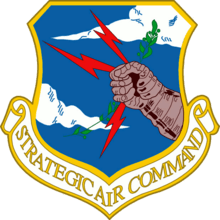



.svg.png)
